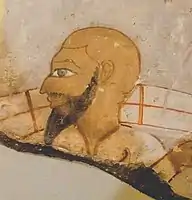Retjenu
Retjenu (rṯnw; Reṯenu, Retenu), was an ancient Egyptian name for Canaan and Syria. It covered the region from the Negev Desert north to the Orontes River. The borders of Retjenu shifted with time, but it generally consisted of three regions. The southernmost was Djahy, which had about the same boundaries as Canaan.[2] Lebanon proper was located in the middle, between the Mediterranean and the Orontes River.[2] North of Lebanon was designated Amurru, the land of the Amorites.[2]
| Retjenu[1] (determ.-foreign land) in hieroglyphs |
|---|
The earliest attestation of the name occurs in the Sebek-khu Stele, dated to the reign of Senusret III (reign: 1878 – 1839 BC), recording the earliest known Egyptian military campaign in the Levant and their victory over the Retjenu: "His Majesty proceeded northward to overthrow the Asiatics. His Majesty reached a foreign country of which the name was Sekmem (...) Then Sekmem fell, together with the wretched Retenu", where Sekmem (s-k-m-m) is thought to be Shechem.[3][4][5] Scarabs with the name "Retjenu" have been found in Avaris, also dating to the 12th Dynasty (1991-1802 BCE).[6]
Kamose, the last king of the Theban 17th Dynasty, refers to Apepi, the Hyksos pharaoh, as a "Chieftain of Retjenu" in a stela that implies a Canaanite background for this Hyksos king.[7]
The name also occurs in the Tale of Sinuhe, inscribed on a piece of limestone in the 14th century BC.
The Retjenu people are depicted in the 18th Dynasty tomb of Rekhmire (TT100).
Overall, numerous mentions of the Retjenu appear in Egyptian inscriptions.[8]
Depictions in Egyptian reliefs
 The Sebek-khu Stele, dated to the reign of Senusret III (reign: 1878 – 1839 BC), records the earliest known Egyptian military campaign in the Levant. The text reads "Then Sekmem fell, together with the wretched Retenu", where Sekmem (s-k-m-m) is thought to be Shechem.
The Sebek-khu Stele, dated to the reign of Senusret III (reign: 1878 – 1839 BC), records the earliest known Egyptian military campaign in the Levant. The text reads "Then Sekmem fell, together with the wretched Retenu", where Sekmem (s-k-m-m) is thought to be Shechem. Egyptian relief depicting a battle against West Asiatics. Reign of Amenhotep II, Eighteenth Dynasty, c. 1427–1400 BC.
Egyptian relief depicting a battle against West Asiatics. Reign of Amenhotep II, Eighteenth Dynasty, c. 1427–1400 BC. West Asiatic tribute bearers in the tomb of Sobekhotep, c. 1400 BC, during the reign of Thutmose IV, Thebes. British Museum.[11]
West Asiatic tribute bearers in the tomb of Sobekhotep, c. 1400 BC, during the reign of Thutmose IV, Thebes. British Museum.[11]
.jpg.webp)
 Syrian tribute bearer from a Theban tomb of the 18-19th dynasty.
Syrian tribute bearer from a Theban tomb of the 18-19th dynasty. A Retjenu. Tomb of Sobekhotep, 18th Dynasty Thebes.
A Retjenu. Tomb of Sobekhotep, 18th Dynasty Thebes.
See also
References
- Faulkner, Ramond O. Middle Egyptian. p. 154. Griffith Institute, Oxford, 1962.
- Steindorff, George. When Egypt Ruled the East. p. 47. University of Chicago Press, 1942.
- Pritchard, James B. (2016). Ancient Near Eastern Texts Relating to the Old Testament with Supplement. Princeton University Press. p. 230. ISBN 978-1-4008-8276-2.
- Manchester Museum: 3306 Stela, Object, Registered, Africa, Egypt, Upper Egypt, Abydos
- The Land of the Bible: A Historical Geography, Yohanan Aharoni
- Martin, Geoffrey T. (1998). "The Toponym Retjenu on a Scarab from Tell el-Dabʿa". Ägypten und Levante / Egypt and the Levant. 8: 109–112. ISSN 1015-5104. JSTOR 23786957.
- Ryholt, K. S. B.; Bülow-Jacobsen, Adam (1997). The Political Situation in Egypt During the Second Intermediate Period, C. 1800-1550 B.C. Museum Tusculanum Press. p. 131. ISBN 978-87-7289-421-8.
- Parkinson, R. B. (2009). Reading Ancient Egyptian Poetry: Among Other Histories. John Wiley & Sons. p. 205. ISBN 978-1-4051-2547-5.
- "The foreigners of the fourth register, with long hairstyles and calf-length fringed robes, are labeled Chiefs of Retjenu, the ancient name tor the Syrian region. Like the Nubians, they come with animals, in this case horses, an elephant, and a bear; they also offer weapons and vessels most likely filled with precious substance." in Hawass, Zahi A.; Vannini, Sandro (2009). The lost tombs of Thebes: life in paradise. Thames & Hudson. p. 120. ISBN 9780500051597.
- Zakrzewski, Sonia; Shortland, Andrew; Rowland, Joanne (2015). Science in the Study of Ancient Egypt. Routledge. p. 268. ISBN 978-1-317-39195-1.
- "Tomb-painting British Museum". The British Museum.
.jpg.webp)

